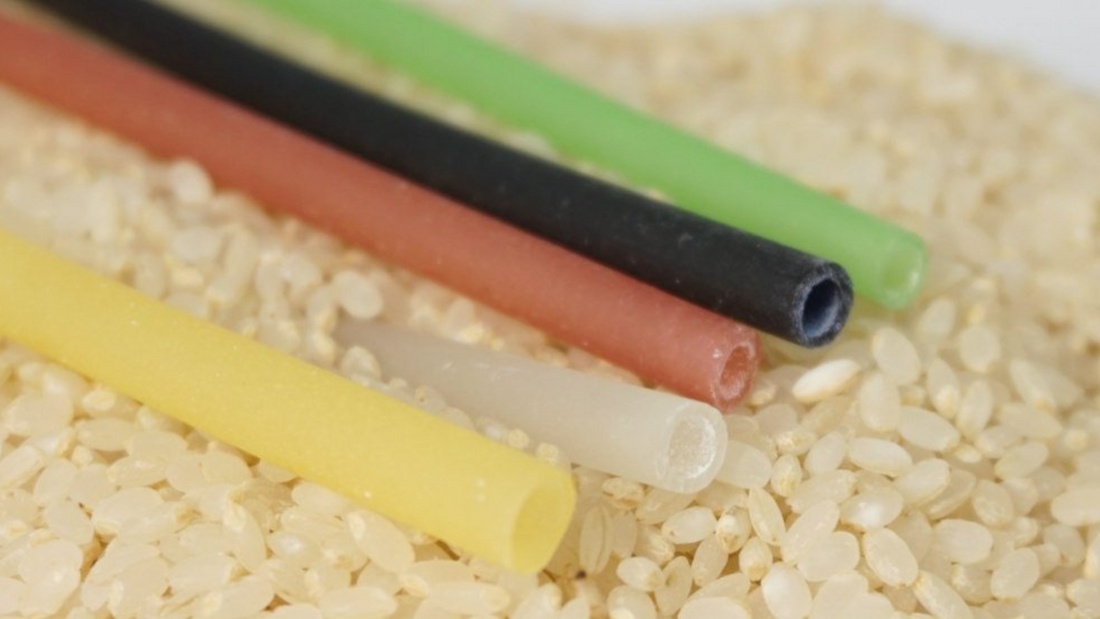With the rising demand for eco-friendly alternatives, rice straws have emerged as a game-changer in the fight against plastic waste. Made from natural rice and tapioca, these biodegradable straws offer a sustainable way to enjoy beverages without harming the environment. But what makes them different from paper or plastic straws? Can rice straws be eaten? And how long do they last in drinks? In this blog, we’ll explore everything you need to know about rice straws, from their benefits and durability to their surprising edibility.
What Is Rice Straw?
Not to be confused with the agricultural by product, rice straw is a drinking straw made from rice flour. Rice drinking straws are designed for single-use and are often available in various colors and sizes.
Rice drinking straws are made from rice flour. They are designed for single-use and are typically round, long, and straight. They come in a variety of lengths, from 14 to 21 centimeters, and diameters to accommodate different types of drinks.
Here are some of the characteristics of rice straws:
- Color: Natural white, can be dyed with natural colors, slightly opaque.
- Safety: Safe to use, BPA-free.
- Heat resistance: Can withstand hot water (about 60-70°C), softens and dissolves in boiling water.
- Composting: Home compostable.
Rice straws, along with sugarcane straws and wheat straws, are considered excellent alternatives to plastic straws because they are made from natural materials.

- Is the Sugarcane Straw the Best Choice for Sustainable Choice?
- Are paper straws gradually replacing plastic straws?
Rice Straws Production Process
Rice straws are created through a six-step process, ensuring their eco-friendly nature:
- Preparing Ingredients: Rice is meticulously chosen, milled into flour, and combined with natural colors derived from plants like sweet gourd, gardenia, magenta, and butterfly pea flowers. These natural colors replace synthetic dyes, emphasizing the sustainable nature of the product.
- Weighing and Mixing: Precise measurements of rice starch, tapioca starch, and natural colors are combined. The proportions are adjusted based on the manufacturer's specific formula.
- Steaming: The combined ingredients undergo a steaming process, encouraging them to bind and form a cohesive mass.
- Shaping: Following steaming, the rice flour mixture is shaped into uniform rice straws using specialized machinery.
- Drying: The shaped rice straws are dried thoroughly, ensuring their durability and resistance to mold. This also allows them to remain intact even when submerged in water.
- Packaging and Delivery: Once dried, the rice straws undergo quality checks, and only those meeting specific standards are packaged for distribution.
The use of renewable resources and a low-energy production process compared to alternatives like metal straws solidifies rice straws' position as an environmentally friendly choice.
How Does Food Packaging Impact the Environment?

Advantages and Disadvantages of Rice Straws
Rice Straw Benefits
Made from rice flour and other natural ingredients, rice straws offer a number of advantages over traditional plastic straws:
- Rice straws are biodegradable and can decompose completely within a few months.
- Unlike plastic straws, which can take hundreds of years to decompose and pollute the environment, rice straws do not pose any environmental harm.
Health Safety:
- Rice straws are free of BPA, PVC, and other harmful chemicals found in plastic straws.
- This makes them safe for use by everyone, including children.
Variety:
- Rice straws come in a variety of colors and sizes to suit different preferences and needs.
- This allows consumers to choose the perfect straw for their drinks and occasions.
Affordability:
- The cost of rice straws has been decreasing, making them more affordable for many consumers.
- This makes them a viable and cost-effective alternative to plastic straws.
Disadvantages of Rice Straws
Despite their numerous advantages, rice straws also have some disadvantages.
Durability:
- Rice straws are not as durable as plastic straws and can become soft or soggy in hot liquids.
- This limits their use in certain applications, such as hot drinks or beverages that require extended use.
Short lifespan:
- Rice straws have a relatively short lifespan, typically lasting only 2-3 hours.
- This means that they may need to be replaced more frequently than plastic straws, potentially increasing costs and inconvenience.
Storage requirements:
- Rice straws require careful storage in a cool, dry place away from direct sunlight.
- Failure to do so can lead to spoilage or degradation, affecting their performance and usability.
Comparison Rice Straws with Other Biodegradable Straws
With their biodegradability, rice straws are a popular choice among various eco-friendly straw options. However, selecting the right type of straw for your business can be challenging.
The following table compares some key characteristics of rice straws with other biodegradable straws, including sugarcane, bamboo, PLA, and paper straws:
|
Characteristic |
Rice Straws |
Sugarcane Straws |
Bamboo Straws |
PLA Straws |
Paper Straws |
|
Material |
Rice flour, tapioca starch, natural colors |
Sugarcane pulp |
Bamboo |
Polylactic acid (PLA) |
Paper |
|
Biodegradability |
Yes |
Yes |
Yes |
Yes |
Yes |
|
Compostable |
Home compostable |
Home compostable |
Home composatable |
Commercially compostable |
Commercially compostable |
|
Durability |
Good |
Good |
Excellent |
Excellent |
Poor |
|
Heat resistance |
Good (up to 60°C) |
Good (up to 70°C) |
Excellent |
Excellent |
Poor |
|
Water resistance |
Good |
Good |
Excellent |
Excellent |
Poor |
|
Cost |
Moderate |
Moderate |
High |
High |
Low |
|
Availability |
Good |
Good |
Moderate |
Moderate |
Excellent |
How to Use and Preserve Properly Rice Straws?
How Long Do Rice Straws Last?
Rice straws are designed for single-use and their lifespan depends on the Temperature of the beverage:
- With hot drinks: They are not recommended for beverages exceeding 60°C (140°F) as they can become soft and soggy within minutes, potentially losing shape or breaking apart.
- With cold drinks: In cold liquids like water, juices, and iced beverages, rice straws can maintain their structure for several hours (2-3), depending on the specific brand and thickness.
Preserve Rice Straws Properly
Here are some ways to ensure proper storage and maximize the lifespan of unused rice straws:
- Store in a cool, dry place: Keep them in a pantry or cabinet away from direct sunlight and moisture. Heat and humidity can accelerate degradation.
- Use an airtight container: Seal them in a container like an airtight box or zip-lock bag to prevent dust, dirt, and insects.
- Minimize handling: Frequent handling can damage the delicate structure, so handle them gently when storing or using.
Where to Buy Rice Straws in Canada?
Rice straws, along with other biodegradable straws, are becoming increasingly popular. They offer a sustainable alternative to traditional plastic straws, which can pollute the environment and harm wildlife.
You can easily purchase rice straws and other biodegradable straws from major e-commerce platforms. This makes it convenient for businesses of all sizes to switch to an eco-friendlier option.
At Kimecopak, we offer a wide range of biodegradable straws in bulk quantities to meet the needs of your business. Our selection includes: paper straws, bamboo straws, sugarcane straws, bio-straws. To learn more about our straws, please contact us via email at halo@kimecopak.ca or visit our Kimecopak Facebook Fanpage.

FAQs About Rice Straws
Do rice straws get soggy?
Rice straws are made from rice flour and have a certain degree of durability. They do not immediately become soggy in water, but they may soften slightly after a period of use, especially in hot water. The exact time depends on the quality of the straw and the temperature of the water.
Can you eat rice straws?
Rice straws are made from rice flour and are generally safe to use with food. However, they are not designed to be eaten and may not be palatable. Eating rice straws could potentially cause digestive problems.
Are rice straws recyclable?
Rice straws are considered a biomaterial, meaning they can break down into natural organic matter over time. This process typically takes a few months, depending on environmental conditions. As such, rice straws are not recycled in the traditional sense along with materials like plastic or metal.
What's the difference between rice straw vs wheat straw?
-
Rice Straw: Made from rice and tapioca, edible, biodegradable, lasts 30–60 mins in drinks, dissolves easily after disposal.
-
Wheat Straw: Made from wheat stalks, not edible, durable for hours in drinks, biodegradable but decomposes slower than rice straw.
Conclusion
In conclusion, rice straws offer a promising and sustainable alternative to traditional plastic straws. While not perfect, their biodegradability, safety, and affordability make them a valuable option for individuals and businesses seeking to reduce their environmental impact.




